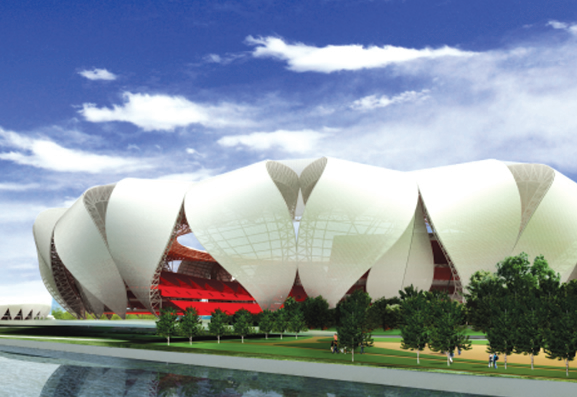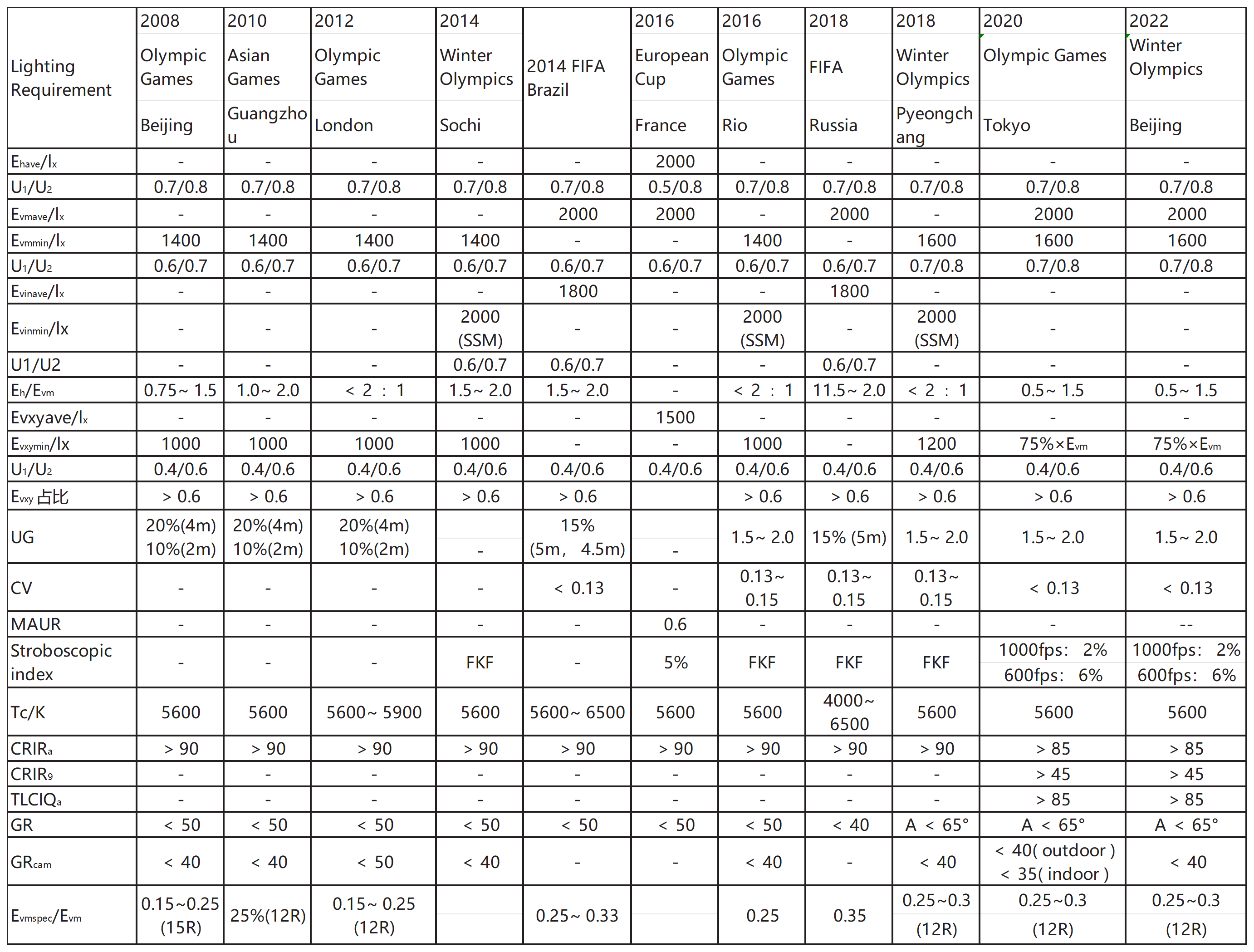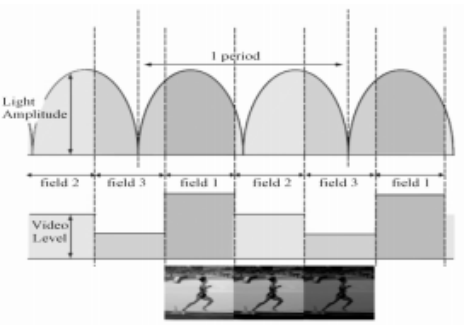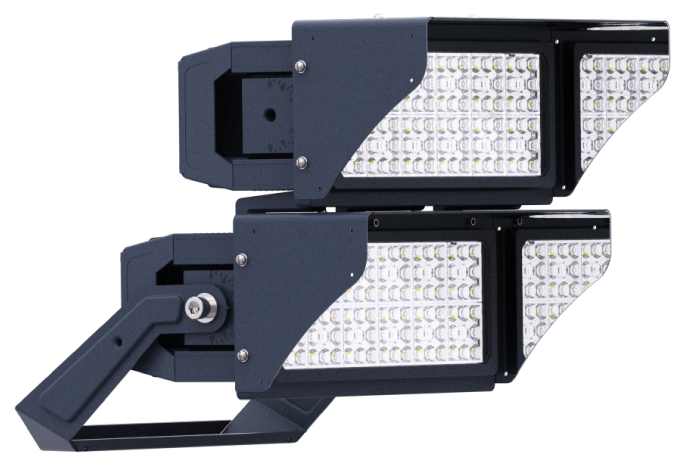Premier Sports Lighting

The design and implementation of premier sports lighting systems incorporate several essential technologies and innovative approaches. Below is a detailed examination of technical optimization, energy-efficient solutions, intelligent control, and user experience:
1. Energy-Efficient and Advanced Lighting Technology
LED technology has emerged as the preferred option for sports lighting due to its high light efficiency and longevity, which significantly lower energy usage. The compact design of LED fixtures minimizes glare risks, although their intense brightness still requires optimization through effective lighting distribution. For instance, in the glare assessment of indoor volleyball courts, the unified glare rating (UGR) model can successfully manage discomfort levels.
2. Intelligent Optimization Design Techniques
Genetic algorithms and rough set theory: In football field lighting design, genetic algorithms (GA) are employed to automatically enhance the arrangement and angle of fixtures, taking into account horizontal and vertical illumination uniformity, three-dimensional effects, and the number of lights, with solutions validated using professional software like AGI32. Rough set theory refines six lighting parameters by examining critical lamp angles to enhance illumination uniformity in large outdoor stadiums.
Dynamic scene management: Wembley Stadium's locker room features an adjustable white light ceiling system that supports various modes such as "focus" before games, "calm" during games, and "celebration" afterward, allowing for flexible scene transitions via a wireless control system.
3. Reliability and Operational Efficiency
The power outage during Super Bowl LXVII underscored the necessity for reliable power systems. Modern sports facilities must implement redundant power supply designs and intelligent monitoring systems to prevent such issues. Additionally, a networked LED system not only boosts energy efficiency management but also enriches the audience experience through color variations and automation features. For example, the Langley Event Center's upgrade utilized wireless control technology to broaden lighting applications in stage performances.
4. Standardization and Adaptability for Various Scenarios
The "Recommended Specification for Lighting in Sports and Leisure Areas" (RP-6-15) from IES provides a foundational framework for design, addressing a range of needs from professional events to recreational activities (like croquet), but it requires customization based on specific project demands (such as compatibility with broadcast equipment). Furthermore, lighting parameters must be adjusted for different sports settings (like indoor volleyball and outdoor football) to balance athlete performance with visual comfort.
5. Premier Sports Lighting Requirements
In 1948, the BBC aired live television coverage of the London Olympics for the first time. The Melbourne Olympics in 1956 marked the first sale of Olympic broadcasting rights. By the Sydney Olympics in 2000, 3.8 billion viewers tuned in to watch the Games on TV. The Beijing Olympics in 2008 saw over 61,000 hours of broadcast time, introducing HD TV coverage. The 2014 Brazil World Cup was successfully aired in 4K resolution. The 2016 Rio Olympics had more than 120,000 hours of TV coverage, reaching over 200 countries with HD signals. The 2018 Pyeongchang Winter Olympics initiated 4K broadcasts, and the 2020 Tokyo Olympics were fully broadcast in 4K. Currently, 47% of the International Olympic Committee's revenue comes from Olympic TV broadcast rights. Cameras used for broadcasts are updated every 3 to 6 months, with a focus on enhancing intuitiveness and detail. Various camera types are utilized throughout competition venues, and 4K/8K signals are becoming standard. High-speed (SSM) and ultra-high-speed cameras (HSSM, 300-900fps) are now standard in TV broadcast equipment. The advancements in broadcast technology and the significant revenue from TV rights for major events necessitate improvements in professional sports lighting. An analysis of the changes in sports lighting standards from the 2008 Beijing Olympics to the 2022 Beijing Winter Olympics can be summarized in Table 1.
Table 1 Professional sports lighting requirements for major world sports events from 2008 to 2022

(1) Adjustments in lighting conditions, consistency, and gradients. To support the production of 4K broadcast signals, venues require improved, more consistent, and uniform lighting. The minimum vertical illumination standards for cameras have been raised, particularly for SSM and 4K/8K broadcasts, with Evmin increasing from ≥ 1400lx/1000lx (fixed/four sides) to ≥ 1600lx/1200lx (fixed/four sides). Additionally, the uniformity of illumination has been enhanced, with horizontal uniformity rising from 0.6/0.8 to 0.7/0.8. For fixed cameras, vertical illumination uniformity has improved from 0.5/0.7 to 0.6/0.7 (field cameras) and 0.7/0.8 (HD/4K). The importance of illuminance gradients is also being emphasized, with CIE specifying gradients UG typically between 10% and 20%, FIFA suggesting gradients of 1.5 to 2.0. and UEFA requiring gradients MAUR to exceed 0.6. Despite the varying numerical standards, the goal of each gradient is to enhance the overall uniformity of field lighting and ensure consistency between adjacent lighting points, thereby improving broadcast image quality.
(2) Standards for the color rendering index of new lighting sources. With the growing use of LED lighting and the need for consistent light sources during TV broadcasts, major international events now require lighting sources to have a CRI(Ra) of at least 90 or Ra of at least 85. with R9 at least 45 (for LED lighting) or TLCIQa of at least 85. to ensure optimal color reproduction during broadcasts.
(3) Flicker-free lighting (FKF). Camera technology is advancing rapidly. Typically, a 75fps camera serves as a high-speed camera for standard TV broadcasts, allowing for slow-motion playback. However, as broadcasting technology evolves, ultra-high-speed cameras operating at 300fps, 600fps, 900fps, and even over 1000fps are increasingly used in sports events to capture more detailed images. When high-speed cameras shoot, each frame has a very brief exposure time. Due to AC power supply issues, power supply frequency, or DC ripple, the exposure from standard sports lighting can vary between frames, leading to inconsistent brightness and flickering during playback, as illustrated in Figure 8. This issue must be addressed for high-speed and ultra-high-speed camera broadcasts. During the 2008 Beijing Olympics, flickering was observed in high-speed camera playback at the Water Cube, and similar flicker issues occurred during the 2010 Guangzhou Asian Games and the 2011 Shanghai FINA Swimming World Championships. Therefore, it is crucial to resolve flicker problems in sports lighting.
Figure 8 Slow motion camera image at 150Hz (P)

During the 2012 London Olympic Games, a newly developed non-flickering electronic ballast and electronic trigger were utilized alongside traditional high-intensity gas discharge lamps for the first time. When all non-flickering high-intensity gas discharge lamps were employed, the flicker index (FF) was below 3%, effectively addressing the flicker issue. This setup performed well in venues such as the London Stadium, the Aquatics Center, and the Velodrome, allowing ultra-high-speed cameras to capture details without flicker. Following this, the 2014 Brazil FIFA World Cup, the 2018 Russia FIFA World Cup, and the 2016 Rio Olympics all implemented similar solutions to mitigate flicker for high-speed cameras. However, the flicker issue was not adequately resolved at the 2014 Sochi Winter Olympics due to the absence of these methods. Beginning with the 2020 Tokyo Olympics, LED sports lighting became widely adopted, and the 2022 Beijing Winter Olympics fully implemented LED sports lighting. By selecting suitable LED driver power supplies, an FF of less than 1% can be achieved. Currently, the 2020 Tokyo Olympics and the 2022 Beijing Winter Olympics require an FF of less than 2% (for speeds under 1000fps) and less than 6% (for speeds under 600fps), while UEFA mandates an FF of less than 5% for Elite A competitions.
Premier sports lighting must combine efficient LED technology, intelligent optimization algorithms, dynamic control systems, and standardized design while considering reliability, energy efficiency, and adaptability to various scenarios. Future developments will likely focus on the deeper integration of personalized lighting environments and research into health performance.
6. Related Product
